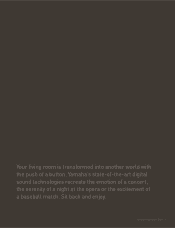Yamaha 2006 Annual Report Download - page 21
Download and view the complete annual report
Please find page 21 of the 2006 Yamaha annual report below. You can navigate through the pages in the report by either clicking on the pages listed below, or by using the keyword search tool below to find specific information within the annual report.
Yamaha Annual Report 2006 21
Professional audio equipment business
Yamaha commercial audio equipment
is used in many of the world-renowned
theaters, concert halls, churches, televi-
sion stations, and other venues. The
Company offers a broad range of mixers,
amplifiers, and speakers that blend accu-
mulated know-how in sound and music
with human interfaces that meet user
needs. Of these products, Yamaha digital
mixers, such as the PM1D and PM5D
models, are establishing themselves as
global standards, reinforcing Yamaha’s
leading share of world markets for
digital mixers.
In fiscal 2006, Yamaha concluded a
strategic alliance with speaker manufac-
turer NEXO S.A., of France. This is part of
the Company’s plan to expand its pres-
ence in markets worldwide as a solution
provider with comprehensive abilities in
such sectors as speakers and amplifiers.
In January 2006, Yamaha also estab-
lished a new sales subsidiary, Yamaha
Commercial Audio Systems, Inc. (YCAS),
in Los Angeles. This is a move to expand
Yamaha’s professional audio equipment
business in North America, the leading
market for such products. YCAS will
work to reinforce Yamaha’s sales net-
work in North America by providing train-
ing and technical and engineering sup-
port for customers and Yamaha dealers.
Manufacturing reforms and business
structure reforms
Yamaha has pursued a variety of initiatives
for business process reforms to improve
the profitability of its musical instrument
operations. Initiatives have included devel-
oping supply chain management sys-
tems, and forging stronger links among
production sites and business divisions to
heighten the sharing of information.
Production line processes have also
been modified to allow standardization
of processes and components. Yamaha
has, as a result, successfully reduced
inventories and shortened lead times for
the production of pianos, by two to three
months, and, with the introduction of a
cell-based production system, of elec-
tronic musical instruments. Despite
improved efficiency, however, reductions
in manufacturing costs and increases in
productivity due to systemic reforms have
not yet yielded improved profitability in line
with projections. Further, there was a
discrepancy in production levels due
to aggressive sales plans at overseas
subsidiaries. But going forward, Yamaha
plans to focus on recovering lost time in
boosting profits, including the use of
more-centralized inventory controls
where feasible.
A crucial decision made in fiscal 2006
was to integrate Yamaha’s two piano pro-
duction facilities in Japan. Besides making
the production of grand pianos and
upright pianos more efficient in light of
piano production volume trends, this move
aims to create an environment that facili-
tates the intergenerational transfer of key
manufacturing techniques and skills.
Efforts to restructure the core musical
instruments business continue apace,
ahead of the formulation of Yamaha’s next
medium-term business plan in fiscal 2007.
Contents business
The contents business derives revenue
from the distribution of polyphonic ring-
tones and true tones, for mobile phones
and from music distribution via computer.
Although sales of polyphonic ringtones
have been on a downward trend, this has
been compensated for by an increase in
sales of true tones.
Yamaha’s polyphonic ringtone distri-
bution services were launched in March
2000 and now span from the mainstay
“MelocchaTM” website to other specialized
websites for melodies using specific instru-
ments, including piano, guitar and
ElectoneTM. The true tone site “UtacchaTM”
has been a hit with the market with its rich
and diverse array of true tone format con-
tents that include tunes unique to Yamaha.
In the “GORGONZOLA” site, which
primarily targets junior and senior high
school students, contents including high-
sound-quality polyphonic ringtones have
proven popular among 10-20 year olds.
Further, Yamaha has extended its ringtone
distribution services overseas to Taiwan,
China, the United States, Europe and
Australia, among others.
As part of efforts to enter new territo-
ries during the period, Yamaha started
an internet-based music distribution
service called “MySoundTM” especially
for broadband users. The contents busi-
ness does not merely gain revenue from
music downloads but also provides
music information through various spe-
cialized websites categorized by music
genre and lifestyle.
Going forward, Yamaha intends to
launch a site that offers information on
various music genres and cultures. At the
same time, plans are to enhance the range
of music distribution services to meet
diversified customer needs. One example
is to sell the songs of amateur musicians
and return the profits to the artists.
UtacchaTM, true tone content
distribution service
Digital mixing console M7CL-48Portable PA System
STAGEPASTM 300
























